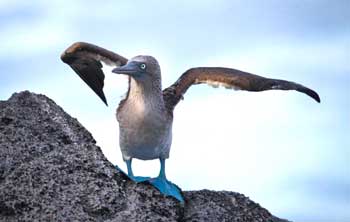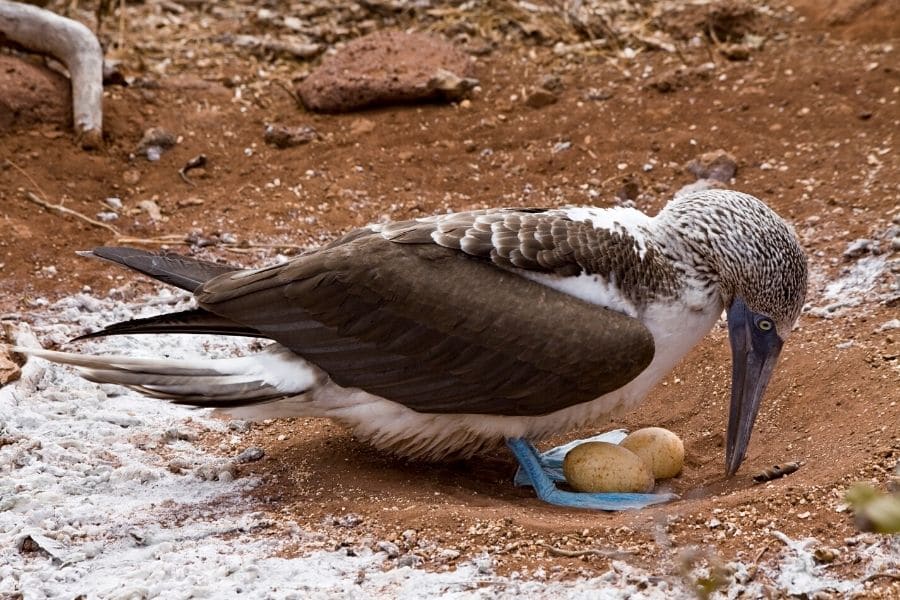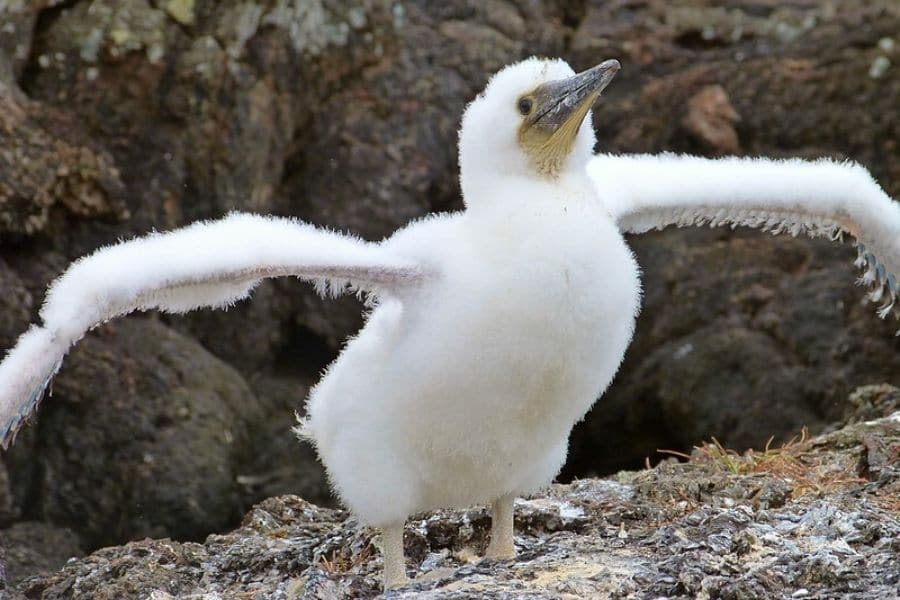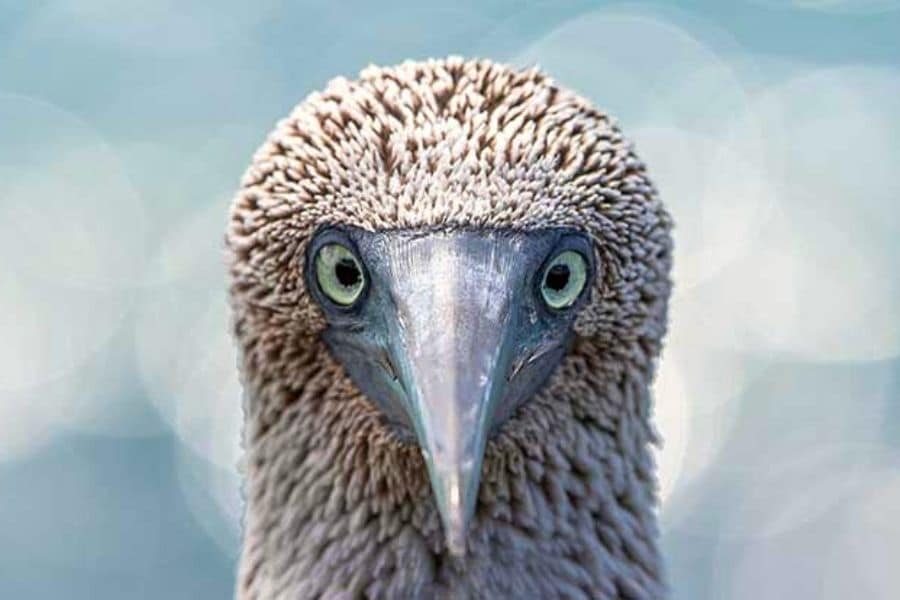Blue-footed Booby Interesting Facts
Stay up to date with our most recent news and updates

Blue-footed booby
Scientific Name: Sula nebouxii excisa
Biological Taxon: Breeding endemic subspecies
Lifespan: 17 years
UICN red list status: Lees Concern (LC)
Range: Along the eastern Pacific coast; In Galapagos commonly nests in colonies on all islands except Santa Cruz and the northern islands (Genovesa, Marchena, Pinta, Darwin, and Wolf).
If you were looking for blue-footed boobies interesting facts, you are in the right place.
In this post, we will tell you several things you should know about this funny and emblematic blue-footed seabird that inhabits the Galapagos Islands.
Blue-footed Booby, a clumsy bird on land.
Blue-footed Boobies are birds with great skill in the air and are excellent swimmers, however, they can confuse us with their “clumsy” behavior on land.
That is why the English name for these beautiful birds (Blue-footed Booby) comes from the Spanish word “bobo” which means silly or clownish and refers to their movements on land. Also, because it can be observed that they are not frightened when humans approach them.

A couple of Blue Footed Boobies posing on the rocks near Kicker Rock.
Blue-footed booby habitat
Where do blue-footed boobies live? This is a good question, they are distributed throughout the islands of the eastern Pacific, from California to Peru.
However, the main reason why you should visit the Galapagos Islands is that 50% of the breeding pairs of blue-footed boobies live there.
The preferred nesting habitat for blue-footed boobies is small islands with rocky shores and cliffs, although they generally like to nest on land.
What their mate selection and courtship ritual is like.
Among blue-footed boobies, the female is the one who chooses her mate. She is not easy to impress, so if the male does not have brightly colored feet, he will not get a girlfriend.
The female looks at the color of the male’s feet, because if they are bright and intense blue, it means that he is in good health and therefore the perfect candidate to become the father of her offspring.
Once the female has picked her mate, it is time for the male to court her with an elaborate ritual that begins when he offers a twig or a stone to the female. Next, the male “dances” around the female, showing off his bright, dazzling blue legs with high steps.
Finally, the female joins the ritual and together with the male culminates the “dance” by pointing her beaks to the sky.
Blue-footed booby, nesting and incubation

The Blue-footed Booby makes no nest, but lays its eggs on bare ground.
In the Galapagos Islands, blue-footed boobies nest in large colonies on almost all islands except Santa Cruz Island and the northern islands (Genovesa, Marchena, Pinta, Darwin and Wolf). So, if you hope to observe them during your next vacation, the chances of seeing them are high year-round.
During the nesting season of blue-footed boobies in Galapagos, which is usually from June onwards, females lay 2 to 3 eggs and the incubation period is 45 days. Afterwards, both parents use their legs full of blood vessels (warm blood) to maintain the temperature of the eggs to incubate them.
What does a blue-footed booby baby look like?

Blue-footed boobies are born without feathers, however after a few days beautiful white down begins to grow all over their body.
When the egg hatches 🐣 we see a beautiful blue-footed booby baby without feathers. However, after a couple of days, the down starts to grow and covers the chick’s body, giving it that fluffy white look we all love. Remember that blue-footed booby babies do not have blue feet, but whitish-gray feet.
Population of Blue-footed boobies in Galapagos
Several studies have shown that the population of the Galapagos blue-footed boobies is declining; Probably due to changes in the availability of its preferred prey, sardines, which has decreased with poaching and illegal fishing in the Galapagos Exclusive Economic Zone.
TOP ENDEMIC SPECIES ON THE GALAPAGOS ISLANDS
Blue-footed Boobies interesting facts:
-
Females are larger than males and have more dilated pupils, so differentiating a female from a male just by looking at their eyes can be easier than trying to guess by their size.
-
Females emit a horrible “honk” and males emit a beautiful whistle. During mating season, a concert of whistling and squawking attracts the attention of visitors to North Seymour and Española Islands, home to the largest colonies of blue-footed boobies in the Galapagos.
-
The pair usually stays together for life. Like other bird species inhabiting the Galapagos Islands, such as the Galapagos albatross, the blue-footed booby is monogamous and remains with its mate for the rest of its life.
-
The blue-footed booby when diving to hunt can reach speeds of up to 60 mph (ca. 97 km/h) diving up to 82 feet (ca. 25 m) deep to reach its food.
-
The color of blue-footed boobies’ legs is due to their diet of blue fish. They hunt schools of sardines, mackerel, anchovies and flying fish. From May to December, the Galapagos seas are especially rich in nutrients and fish, so boobies and other seabirds are very active at this time.

Female blue-footed boobies are slightly larger than males and also have larger pupils, so they can be easily distinguished.
Undoubtedly, Galapagos blue-footed booby is a unique and special endemic species, which you will be able to see if you decide to visit the wonderful Enchanted Islands. Take an excursion on one of the best cruises available, or even on an island-hopping tour to spot the beautiful blue feet birds.
Live the Experience with Cruise to Galapagos!
📌 Discover our best Galapagos Islands Cruise Deals! Click here.
RELATED POST
Traveling to the Galapagos Islands in 2022: tips, what to do, and how to book the best trip ever
Learn more about the Galapagos Islands and how to make the most of your trip to this natural destination with this quick guide.
Best Time to visit the Galapagos Islands
Discover the best time to visit Galapagos. Learn about the weather, wildlife and the best time for activities both on land and in the water.



